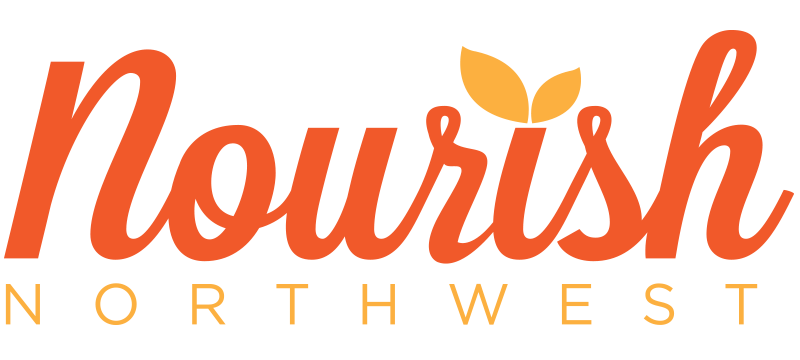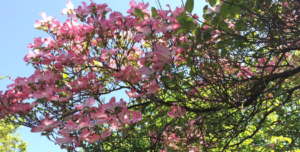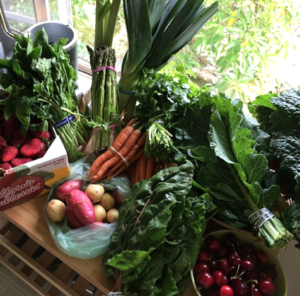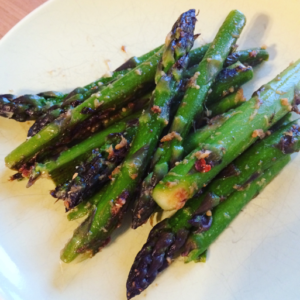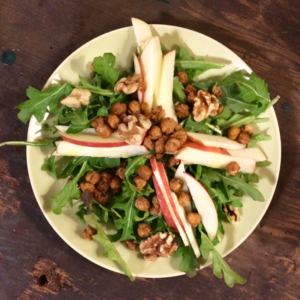Top 5 Tips To Be Your Best You This Spring
Top 5 Tips To Be Your Best You This Spring
Written by Miah Williamsen, MScN (August 2018)
Miah is a nutrition graduate student at National University of Natural Medicine in Portland, OR and intern at Nourish Northwest. She is passionate about teaching others how to use food and lifestyle choices as therapeutic tools to optimize their physical, mental, and emotional health.
Spring has officially arrived in Portland and, I for one, am incredibly thankful for the sunshine after the long, grey, wet winter. This was my first winter living in Portland, and even though it was mild compared to previous years (or so I am told), I am happy to be transitioning into warmer, sunnier weather.
Spring is all about potential – potential for change, potential for growth, potential for optimal health and happiness. Just think about the myriad changes that take place in nature in the springtime: trees blossom, bulbs bloom, vegetables sprout, bees buzz, and birds sing as the weather gets warmer and the days get longer. Everything grows and comes alive in the springtime, and so can you!
Spring is the perfect time to embrace change, try something new, plan for the future, and discover how to have vibrant health and wellbeing.
The up and out energy of this season, called “yang” in traditional Chinese Medicine, will support you during this process. If energy medicine is not your thing, simply think about how energizing the warm, sunny, light-filled days of spring are (especially compared to the gray gloom of a Pacific Northwest winter). The early morning light and sunshine certainly wake me up and give me a boost to get going in the a.m., even without coffee!
You do not have to do a month-long juice cleanse, start going to the gym for 2 hours per day, seven days a week, or change your entire life in order to take advantage of this ideal transition time or to thrive in the spring.
Rather, I suggest that you make a few small, simple changes to your current routine in order to be your best you this spring. To get started, try one or more of the tips below to optimize your health and happiness in the springtime.
- Spend time outside in the sunshine.
Make a point of going outdoors and getting some fresh air every day, even if only for 15 or 20 minutes. While any time outside in the sunshine is beneficial to your physical and mental wellbeing, time spent in nature – whether in a park, in a forest, or on the beach – has exceptional health benefits. The Japanese practice of Shinrin Yoku, or forest bathing, in which you spend unstructured time in nature (that is, time to just “be”, not dedicated to exercise or work), has demonstrated numerous health benefits in scientifically validated studies, including improving immune system function; alleviating anxiety, depression, and stress; and inducing mental and physiological relaxation. If simply sitting under a tree and relishing in the beauty of nature can do all that, I’m in!
- Be active.
Shake off the stagnation of winter by moving your body. Any form of movement is encouraged. According to the Ayurvedic tradition, physical activity in the springtime is best done in the early morning and outdoors, and it should make you a little bit sweaty. Exercise does not need to be extremely vigorous, but should be invigorating and get your blood flowing. I recommend that you do something that you enjoy, whether it be walking, running, playing soccer, or attending a fitness class. My preference is a long walk around the neighborhood, either in the morning or mid-evening, followed by some gentle stretching and a breath practice.
- Try something new.
As spring is all about new beginnings and future planning, it is the ideal time to try a new something, whether that be a new hobby, a new sport, a new leisure activity, or even a new food. I encourage you to step out of your comfort zone and embrace the unknown. You may discover something you love, increasing your happiness and propelling you to grow, just as springtime intends.
- Wear layers and weather-appropriate clothing.
Spring is a tempermental season. It can be warm and sunny one day, and cold and rainy the next, especially in Portland. So, in order to prevent catching a cold or getting a sunburn, I suggest that you wear layers in the springtime. This will make adjusting to the ever-changing weather and temperature easier, as well as make sure you stay healthy and happy. The last thing you want is to catch a spring cold and be stuck inside! Traditional Chinese Medicine encourages you protect your neck and ears in the springtime (think scarves and hats), to avoid overexposure to the wind and lingering cold of winter. This recommendation can also extend to the lingering dampness of a Pacific Northwest spring.
- Eat seasonally.
The best foods to eat in the springtime are foods that grow in the springtime. Think tender greens, asparagus, peas, artichokes, arugula, and all forms of sprouts. Anything labeled as “baby” – baby spinach, baby kale, baby spring greens – is a great, seasonal option. Sprouts, in particular, are highly recommended as they are the literal embodiment of new growth and potential for greatness!
A good rule of thumb is: if you can find the food at your local farmers market, it is a good choice for springtime. However, if shopping at a farmers market is not an option, have no fear! You can find plenty of seasonal produce at your local grocery store. Usually the fruits and vegetables on sale or on “special” are the ones that grow most abundantly at the time and are, thus, “in season”.
The energetic qualities of spring foods support health in myriad ways. They can be used to energize us, to alleviate springtime congestion and allergies, and to support movement and growth in our bodies. Traditional Chinese medicine recommends consuming sweet foods to help us to soften and relax in the springtime and pungent foods to awaken us and help move our energy up and out. The use of herbs that stimulate and awaken the senses is also highly encouraged. The best foods and herbs to consume in the spring, according to Chinese medicine include:
Baby vegetables
Asparagus
Snow peas
Green vegetables
Whole grains
Legumes
Seeds
Sprouts
Honey
Watercress
Chives
Garlic
Arugula
Mint
Rosemary
Thyme
Lemon balm
Ginger
You will notice that many of these foods are found in abundance in the springtime, making it even easier to eat with the season.
Honey (as well as bee pollen) is particularly helpful for alleviating springtime allergies. Locally-sourced honey contains pollen from plants in the region, and thus serves to inoculate you against allergy-causing pollens in the air. Opt for raw, local honey for maximum allergy benefit.
I think that eating foods that are locally grown and seasonally available is the best way to support your health and vitality in the springtime, regardless of the healing tradition. The following recipes incorporate many of the above suggested foods so that you can put these seasonal food suggestions into practice. Whip them up at home and enjoy what spring has to offer, while nourishing your body and soul.
Stimulating Quick-Sautéed Asparagus
Serves 2
Ingredients:
1 T avocado oil
2-inch piece of ginger, finely grated (on a microplane)
5 cloves of garlic, pressed (through a garlic press)
1 bunch of asparagus, tough ends trimmed off and cut into 1 inch pieces
1 pinch of dried chili flakes
Salt and pepper, to taste
Instructions:
- In a medium-sized skillet, heat the avocado oil over medium heat.
- Add the garlic and ginger and cook for 30 seconds or until fragrant.
- Add asparagus, chili flakes, and a pinch of salt and pepper and quickly sauté, stirring frequently, until asparagus is bright green and cooked al dente, 3-5 minutes.
- Remove from heat and enjoy immediately.
Rationale:
This dish is meant to be stimulating and uplifting to help energize you in the springtime. It features garlic and ginger, which are both pungent, warming herbs that stimulate, awaken and help to move energy up and out. Moreover, both the Chinese Medicine and Ayurvedic traditions recommend that all people incorporate garlic and ginger into their meals in the springtime to promote mobilization and awaken the senses. Asparagus is a bitter vegetable that is abundant in the spring and is considered supportive of all people in the springtime. Bitter foods, like asparagus, also help to unblock blockages (such as clogged noses), dry excess dampness, and stimulate digestion.
Spicy Roasted Chickpeas and Arugula Salad
Serves 4
Ingredients:
For roasted chickpeas:
2 cans chickpeas, drained, rinsed, and patted dry
2 T avocado oil
2 tsp dry mustard powder
1 tsp garlic powder
¼ tsp cayenne pepper
Salt and pepper, to taste
For salad:
6 cups of arugula
1/3 cup fresh mint, finely chopped
1 apple or pear, diced
⅓ cup walnuts, chopped (or other nut or seed of choice)
1 clove garlic, pressed (through garlic pressed)
2 T extra virgin olive oil
2 T vinegar of choice (I like apple champagne or balsamic)
Salt and pepper, to taste
Instructions:
- Preheat the oven to 400 degrees Fahrenheit. Line a rimmed baking sheet with parchment paper.
- Place chickpeas in a large bowl. Drizzle with avocado oil and sprinkle with mustard, garlic powder, cayenne, a dash of salt, and pepper. Stir to evenly coat all chickpeas with spices and oil.
- Spread chickpeas out onto the baking sheet and place in the oven.
- Roast for approximately 15-20 minutes, then stir, and then roast another 15-20 minutes or so, until chickpeas are crispy and golden. Then, remove from oven.
- Prepare the vinaigrette: whisk together olive oil, apple cider vinegar, pressed garlic, salt, and pepper.
- Toss the salad: add arugula, mint, apple or pear pieces to a large bowl. Drizzle with vinaigrette, and toss to coat. Add roasted chickpeas and gently stir to incorporate them.
- Serve and enjoy.
Rationale:
This recipe features a number of foods that are highly recommended for consumption in the springtime. Chickpeas are astringent legumes that will help to absorb moisture and stop the flow of fluids (such as runny noses) that may be caused by allergies. Legumes, in general, are very supportive in the springtime. This dish also features pungent and warming garlic, mustard, and cayenne to stimulate you, break up winter stagnation, and encourage more movement. Cooling mint has also been included to awaken and stimulate the senses. Arugula is a bitter green that is excellent in the springtime to dry dampness, ease congestion, and support digestion, all of which will promote your health in the spring.
